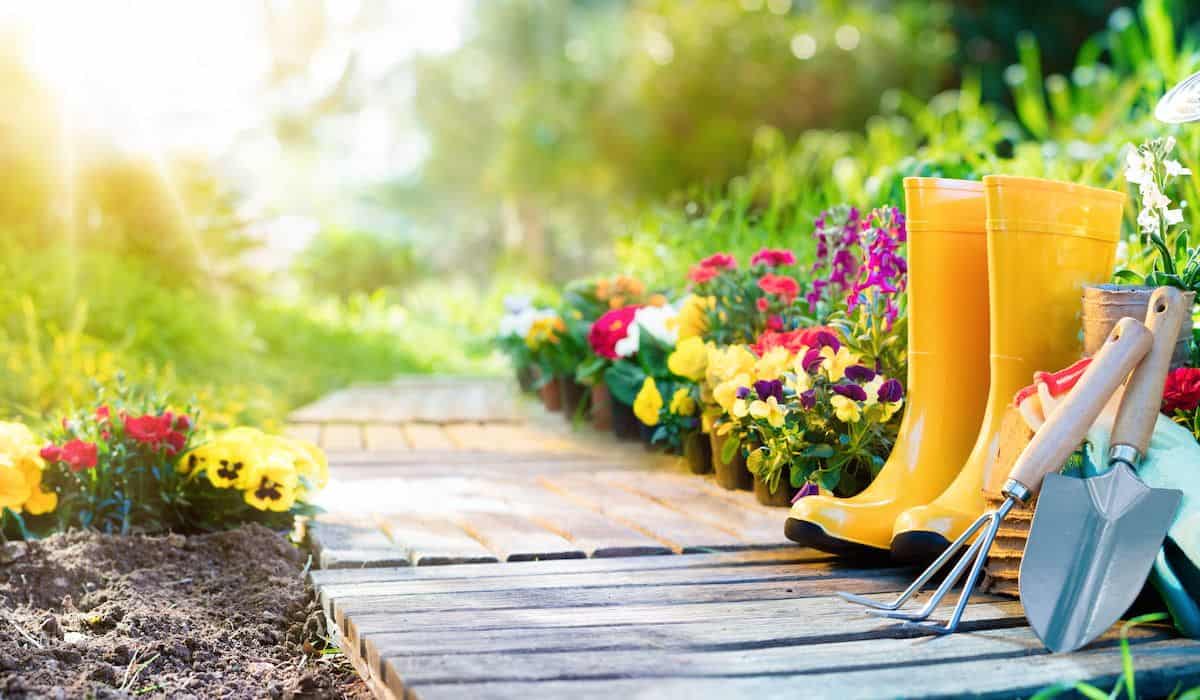Are you considering trying your hand at being a gardener?
It’s okay if you don’t have a green thumb, it’s less about skill than it is about heart, and of course, a bit of know-how!
Learn about soil, pruning, watering, pests, and more, in this complete guide for the gardening beginner.
What Makes Gardening Great?
What is there to love about gardening? So much. Here are some things gardening is great for:
Relaxation
Gardening is a tactile hobby that engages almost all the senses: the smell and feel of dark, rich soil; the sound of birdsong; the beauty of the sunlight and green, and healing, fresh air.
While you’re nestling little seeds into the soil, watering thirsty plants, and harvesting berries, it’s easy to lose yourself.
Your Health
Did we mention sunlight and fresh air? These are reinvigorating, helping purify the body, and providing essential vitamin D. As touched on above, it’s also an excellent source of stress-relief.
Not only that, but you can control what goes into home-grown produce. This means no undesirable pesticides, GMOs, etc. Fruits and veggies are also an invaluable source of nutrients, energy, and fiber.
Freshness and Flavor
Garden-grown produce has incomparable freshness and flavor. They are at their crispest, sweetest, and richest.
Fruits and veggies from your garden can be used to create magnificent salads, stir-fries, soups, smoothies, jams, pies fillings, sauces, and stand-alone dishes (steamed or baked and seasoned lightly).
What Gardening Supplies Do You Need?
- A sunhat. An old-fashioned, wide-brimmed sunhat to protect you from the sun’s glare.
- Sunscreen. Sun-protection is key.
- A kneeling pad (optional). So that you can garden in comfort.
- A watering can. For plants that need a personal touch and to gently water seeds (a sprinkler can sometimes disturb these if you use it too soon).
- Gloves. You may want gloves in order to keep dirt from getting under your nails, protect your skin from prickles, avoid touching bugs, etc.
- A trowel. To loosen up the soil and dig holes for bulbs.
- Your plants of choice. Consider looking into plants that pair well together. Some will fight each other’s pests off (like garlic).
- Gardening soil. Look for a well-draining, high-quality soil (this can be found at your local hardware store, supermarket, or online).
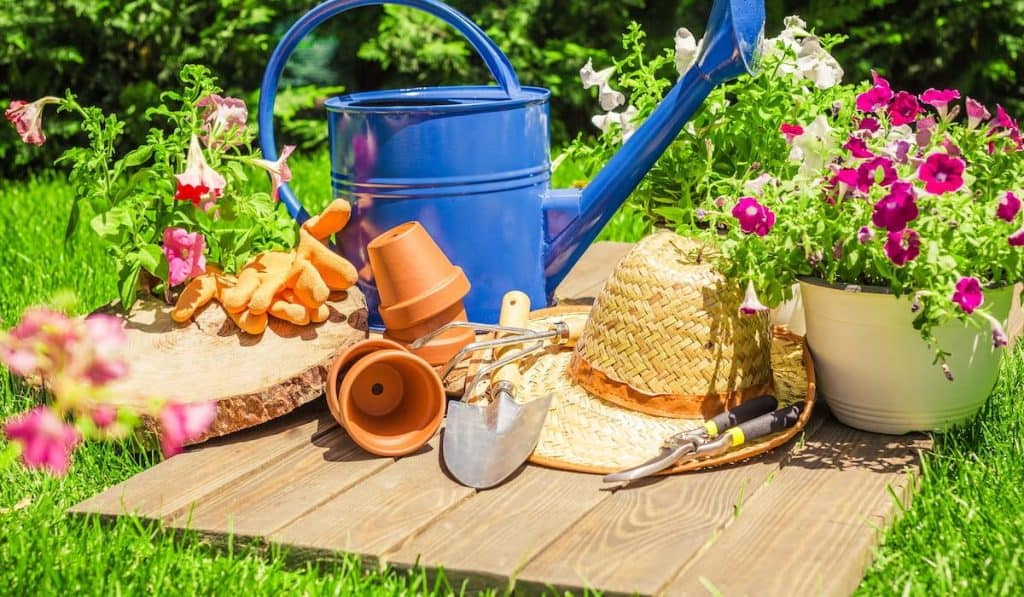
When Should You Plant Your Garden?
Just about everything in your garden should not be planted until after the last frost. Frost will simply kill it off. Some plants can handle it cooler, while others like it to be warmer. Here’s a basic planting chart for the beginner.
| Feb | Mar | April | May | Jun | July | Aug | Sept | Oct | |
| Tomatoes | X | X | |||||||
| Strawberries | X | X | X | ||||||
| Lettuce | X | X | |||||||
| Carrots | X | X | X | ||||||
| Potatoes | X | X | X | ||||||
| Radishes | X | X | |||||||
| Zucchini | X | X | X | ||||||
| Raspberries | X | X | X | ||||||
| Rosemary | X | X | |||||||
| Rhubarb | X | X | |||||||
| Basil | X | X | X | ||||||
| Pumpkins | X | X | X |
What Can You Grow in Your Garden?
You can grow a vast selection of plants in your garden, including veggies, fruits, greens, and herbs. Here are some of the most popular.
What Are Some of the Most Popular Vegetables to Grow?
Vegetables are perhaps the most popular thing to grow in gardens, next to flowers. This is because vegetables are hardier than fruits and greens, so growing them is easier.
You can use home-grown veggies to make tender stir-fries, savory soups, fresh sauces, salads, health drinks, and more.
- Corn. Corn is nice and easy to grow, all you need is sufficient space (and of course, the proper watering, soil, and general care). Plant corn in short rows, each kernel about 1 inch deep, in a space of at least 10 feet in diameter.
- Carrots. Carrots are also a breeze to grow, they just take some time to germinate. Plant the seeds no more than 1/4 inch deep, in rows that are 3 inches apart, and spaced 1 foot from one another.
- Zucchini. Sow zucchini seeds about 1 inch deep in the spring and pick once the zucchinis have reached a respectable size and ripened to a rich green color.
- Cucumbers. Cucumbers should generally be planted a few feet apart. They will grow quickly and with minimal care. They can be grown on a trellis, just 1 foot apart, or in the garden bed itself.
- Tomatoes. Tomatoes need plenty of space of their own, and tend to do best in pots, or spaced generously in the garden itself. Oftentimes they will need a tomato cage to hold them up, especially as the fruits become ripe and heavy!
- Bell Peppers. Bell peppers must germinate indoors before you introduce them to your garden. They need plenty of moisture, peat, warmth, and dark before the sprouts have appeared and are big enough to transfer.
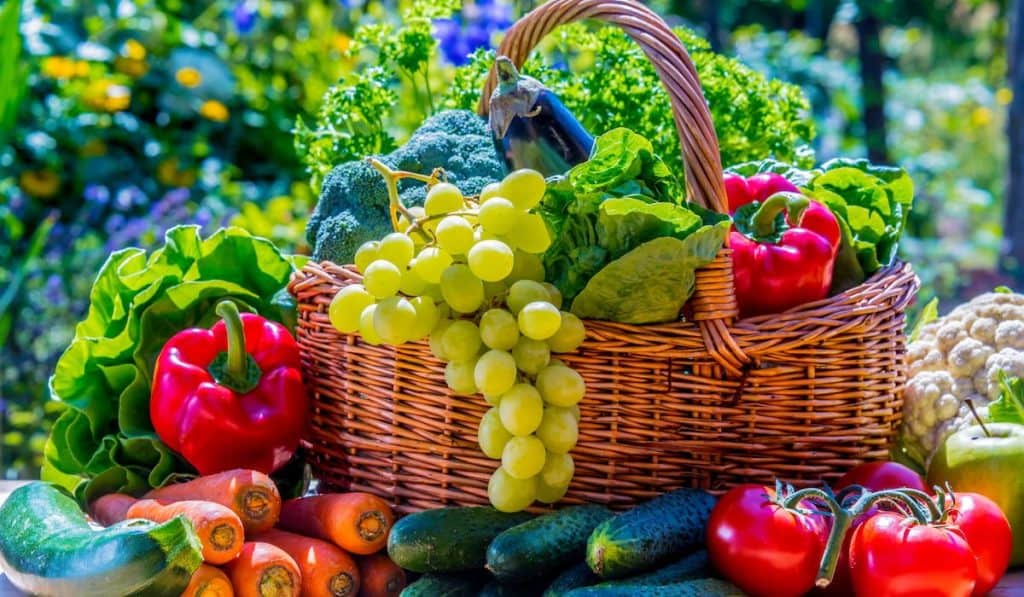
What are Some of the Most Popular Fruits to Grow?
The key to growing fruit is warm temperatures and several hours of sunlight daily.
Garden-fresh fruit is far and away better than store-bought, as it is much sweeter and more flavorful, not to mention riper (literally straight off of the vine).
You can turn homegrown fruit into pies, smoothies, salads, jams, syrups, juices, and more.
- Strawberries. Have you ever had garden-fresh strawberries? They are simply delectable. Compared to store-bought strawberries, they are more tender and sweeter. You can also pick them at their ripest, which stores cannot do (or else they would spoil en route). Be sure to space the strawberries at least 18-inches apart, because they will propagate themselves with little, vine-like runners (and they’ll need some room).
- Raspberries. Just like garden-fresh strawberries, garden-fresh raspberries are virtually incomparable. You can pick them at their prime, to enjoy straight from the vine or made into jams, pies, and more. To grow raspberries, plant them 3-4 feet apart, with a fence or trellis to crawl up, and plenty of sunlight every day.
- Grapes. Grapes are grown much like raspberries and require ample sunlight and a fence or trellis. They can be turned into juice (like grape cider), jam, salad toppings, wine, and more.
- Watermelons. Watermelons should be planted in late spring to early summer when the weather is dependably warm. You can also germinate them indoors if necessary. To germinate properly, watermelons require temperatures of at least 70°F.
What Are Some of the Most Popular Flowers to Grow?
Flowers need lots of sunlight and gentle pruning in order to thrive, and they will transform your yard into a space of fragrant beauty and wonder.
- Roses. Roses are some of the most gorgeous flowers out there, and perhaps the most popular. For beautiful roses, the key factors are well-draining soil, pruning, and fertilizer. Prune dead roses away to make room for new blossoms and fertilize once or twice monthly.
- Wisteria. Wisteria grows on artfully twisted wooden vines and hangs clusters of blossoms down like earrings. It is a sun-loving trellis flower.
- Lilacs. If you’ve been around lilacs before, you no doubt know of their distinctive, heady fragrance. These light purple flowers grow in fat, grape-like clusters, with pointed petals like a star. Like roses, healthy, showy lilacs depend largely on pruning and fertilizer.
- Daisies. These beloved little flowers exude cheer. They must germinate before they will grow, and then it will take a year’s growth in order for them to flower. Daises will return every year.
- Asters. Asters are not only super-attractive to bees and butterflies, but they’re also extremely hardy and will bloom all year. You can even see these lovely, daisy-like purple flowers in late Autumn and early winter.
- Echinacea. Related to the Daisy, these flowers are native to North America and are commonly called the ‘coneflower’. Petals of purple or pink surround a spiky cone-shaped seed head.
- Irises. Among flowers, irises are some of the most queenly. They are huge flowers with some petals that stretch outwards like a banana peel, and some that stick up like a feather. The result is a rather alien-looking but absolutely gorgeous flower. Irises come in just about every color and are known for their varying fragrances and noteworthy shimmer. Plant the bulbs in the autumn for a striking May-June flower.
- Crocuses. Crocuses (Crocii) are the heralds of spring, as they are one of the first flowers to peek up through the snow. Amidst all the white, they make vivid drops of color. They come in many hues, including royal purple, orange, yellow, pure white, and lavender. Plant in the autumn to enjoy this delicate spring flower.
- Tulips. Have you ever been to a tulip festival? These tall, bowl-shaped flowers grow from bulbs every spring and create a show of variety and color.
- Peonies. Peonies are similar to roses, but with even more petals growing in a rosette. They are known for their sweet smell, like honey or sugar.
- Marigolds. Growing these bright, merry flowers couldn’t be easier.
What Are Some of the Most Popular Greens and Herbs to Grow?
- Lettuce. Although it is pest-prone, lettuce is one of the easiest greens you can grow. Wait until after the frost to sow. Garden-fresh lettuce can be used to create salads that are incomparably sweet, flavorful, crisp, and tender.
- Spinach. Compared to lettuce, spinach is a bit harder to grow. This is because, while it, too, must be planted after the frost, spinach thrives in cool weather. It should be planted ASAP – but not too early, either.
- Kale. This is a super-food you can grow on your own. Toss it into smoothies and salads or bake it into kale chips for a snack that couldn’t be healthier.
- Cabbage. Here’s the secret to growing cabbages: the farther apart you space them, the bigger they will grow (within reason). Sow mid-to-late summer.
- Swiss Chard. You can germinate Swiss Chard indoors, or outside even before the last frost. They will peep up from the soil as it gets warmer. This is another healthy food and a crisp, zesty salad ingredient that is highly sought-after.
- Rosemary. Rosemary is a fragrant herb used to season chicken and soups, make traditional rosemary focaccia, and more. It grows best in the full sun, with loamy soil and a pH anywhere between 6-7.
- Basil. This is another fragrant herb that is to-die-for. The sweet and tender plant requires well-draining soil and prefers lots of sunlight.
- Mint. Mint grows with enthusiasm, so you may need to make sure it doesn’t become invasive in your garden. For this reason, you may prefer a pot or planter.
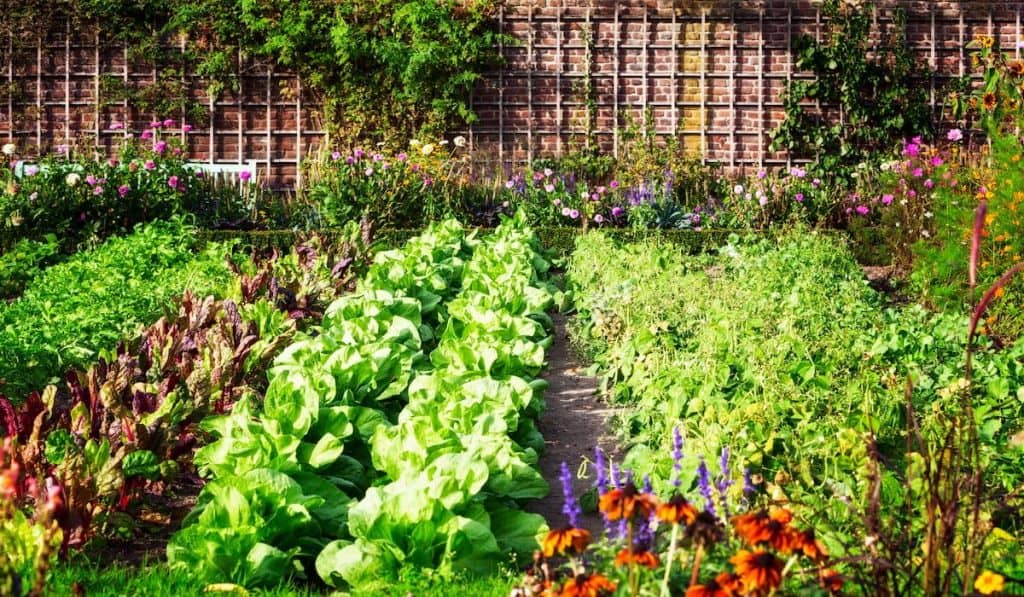
Growing Difficulty Chart for Common Crops
To get you started, here is a little growing difficulty chart for some of the most popular plants you can grow in your garden:
| Difficulty | Easy | Medium | Hard |
| Strawberries | Raspberries | Broccoli | |
| Carrots | Grapes | Watermelons | |
| Lettuce | Pumpkins | Eggplants | |
| Zucchini | Cherry Tomatoes | Onions | |
| Peas | Spinach | ||
| Cucumbers | Cauliflower | ||
| Radishes |
What Kind of Soil Should You Use?
The type of soil you should use varies by plant, though it should be well-draining as a general rule. Any plant is at-risk of various diseases, most notably root or crown rot if allowed to become soaked.
Tropical plants, like African Violets, love humidity, so they often appreciate a bit of peat mixed in with the soil to help it retain more water.
It’s an altogether different story for succulents and cacti. These prefer extra well-draining soil and would rather have too little than too much water.
Some of the best things to add to the soil to help it drain are sand, perlite, and gravel. Many stores will also carry special succulent or cactus mix.
You’ll want to place your plants together according to soil type as well as lighting preferences, ideally!
How Often Should You Water Your Garden?
It’s best to water your garden more thoroughly and less frequently, rather than less thoroughly and more frequently. It’s advisable to water your garden generously no more than once or twice a week.
Why? Because deep watering is ideal for promoting deeper root growth, promoting plants that are hardier, healthier, and happier.
Make sure to water in the early morning or evening; you may wish to water only in the morning as the season progresses and the nights grow colder.
It’s never advisable to water in the afternoon, as the sun at its zenith will cause the water to evaporate too quickly and scald the leaves of your plants. Better to water earlier.
How Much Sunlight Do Plants Need?
The degree of sunlight plants need varies considerably, with some being true sun-lovers, and others more at home in the shade. It’s important to pay attention to this because without enough sun, light-loving plants will lose their color and vigor.
Plants that need shade, on the other hand, will scald in direct sun, and eventually, wither.
Plan your garden according to light and shade distribution, so each plant receives its ideal light conditions, accordingly.
What Do You Need to Know About the Hardiness Zones?
The hardiness zones are 11 zones used to indicate different climates in the world. It will tell you whether or not a plant can be kept outside where you live successfully.
Some plants require the ever warm and humid environment of the East Coast, for example, Florida, which is in hardiness zones 9-11.
Others can survive in or even prefer colder climes, making them suitable for zones such as 4-5.
What is Soil pH and Why Does it Matter?
The soil pH is an indicator of how acidic or alkaline it is. Some plants prefer one or the other (or somewhere in-between). Others are not so particular.
Do You Need to Prune Your Plants?
Plants should be pruned whenever parts of them become sick or die off. Spent flowers should also be removed.
Pruning a plant will spare up energy being expended unnecessarily for further growth, flowering, and vitality.
You can also prune plants to decrease their size and keep their growth in check.
The Top 5 Pests to Look Out For
Unfortunately, you’re not the only one interested in enjoying some fresh fruits, veggies, and greens; plenty of pests have also got their eye on your produce!
Signs that your garden has pests are holes in the leaves, trails of slime, left behind snail shells, and yellowing (make sure the latter is not due to overwatering or lack of light).
- Snails and slugs. The signs of a snail and slug infestation are clear: slime trails and munched-on leaves. There will also usually be snail shells left behind.
- Aphids. You can tell a plant has aphids because it will be covered in a sticky substance. This is what they leave behind as droppings, called honeydew, and it’s created from the sap they leech from plants. Aphids are visible to the naked eye, as tiny, round, bright green, winged bugs. They tend to stick to leaves and stems in a cluster.
- Codling Moths. These are small gray, bark-patterned moths that infest primarily fruits, burrowing inside them to eat the flesh and to lay eggs. You can tell a given fruit has been infested by codling moths if it has brown, bruised holes in it.
- Thrips. Thrips can be a particularly devastating pest, and leaves afflicted by them will turn yellow, leeched of sap and color. Thrips resemble tiny, see-through shrimps or lobsters, and leave tell-tale exoskeletons behind. Like aphids, they tend to cluster.
- Cabbage Loopers. The cabbage Looper, despite its cute appearance, is one caterpillar you probably don’t want around. These little guys like to help themselves to garden-fresh greens, like lettuce, spinach, broccoli leaves, cauliflower leaves, kale, etc.
- White Flies. Whiteflies are the most harmful to plants when they are still larvae. They cluster and feast, leaving behind honeydew and causing leaves to weaken and ultimately die off.
- Cut Worms. Cut Worms are fat brown or gray caterpillars that live on the soil and feed on roots. They can destroy a plant completely from below and should always be gotten rid of.
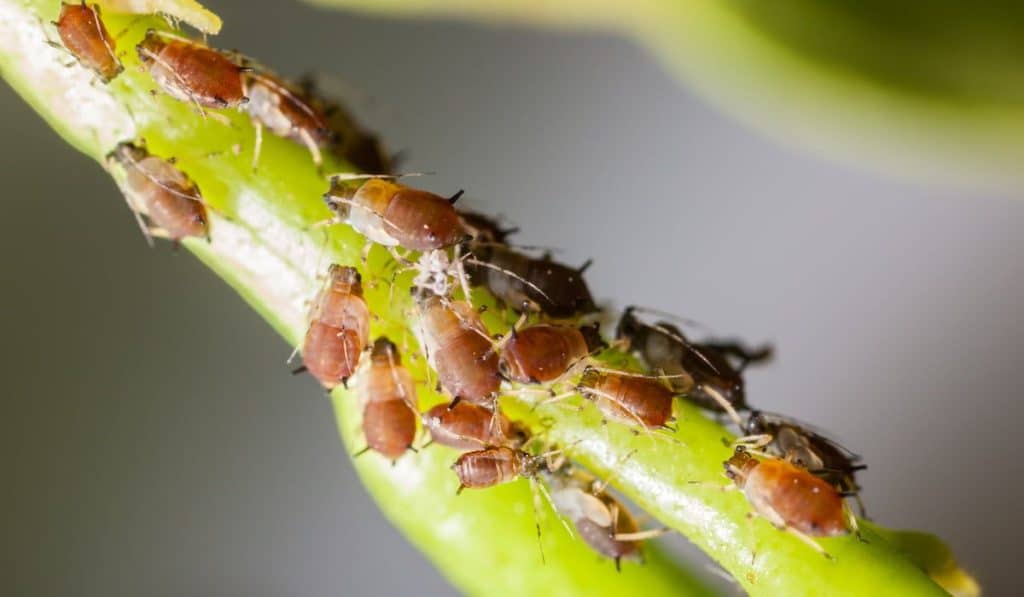
How Can You Get Rid of Pests?
So, now that you know some of the most common pests, how can you get rid of them? One of the most environmentally friendly options is horticultural oil.
Applying this directly to pests and afflicted parts of plants can cause pests to become coated in it, hindering their movement and causing them to suffocate.
The next most environmentally friendly option is Neem Oil. Alone, this tree-based oil is toxic when consumed, but it can be sprayed sparingly on plants safely. Focus on areas that are the most chewed, or where you can actually see the pests in a cluster.
Finally, you can try a good, old-fashioned insecticide. Just avoid eating the produce (and prevent curious pets or children from sampling it) until after a few good watering’s and rinsing’s, so you know you’re in the clear.
What Plants Are Toxic to Pets or Children?
- Tomato leaves. These are poisonous to cats, dogs, rabbits, hamsters, and guinea pigs, and most other pets.
- Garlic. This is one of the most deadly plants for cats, dogs, rabbits, hamsters, and guinea pigs, and more other pets. It can cause sometimes irreparable damage to the blood cells directly.
- Rhubarb. The leaves of rhubarb plants are chock-full of oxalic acid. This can cause gastrointestinal upset, or, if eaten in large amounts or too frequently, it will even cause kidney problems and kidney failure. Every part of the plant is poisonous to just about every pet.
- Lily of the Valley (and lilies in general). Lily of the Valley is a beautiful yet incredibly toxic flower. For pets, ingestion or the inhalation of pollen often results in irreparable damage to the liver. It’s a known killer.
- Daffodils. Pretty as these flowers are, they are poisonous to pets and children alike.
What to Know About Fertilizer
Vegetable and fruit gardens will generally require fertilizer once every 3-4 weeks (you could say once monthly).
The fertilizer should be a complete formula, and roughly twice as much phosphorous as nitrogen and potassium. Mix it into the immediately surrounding soil of your plants thoroughly.
For the maximum harvest, continue to administer fertilizer even as fruits and veggies begin to appear.
It probably goes without saying, but plants don’t require fertilizer over the winter. This is their dormant season, and plants are asleep or dying off.
So, what do you think? Is gardening a hobby for you?
Fresh strawberries or garden-fresh salads make the hands-on task well worth it, to many!

